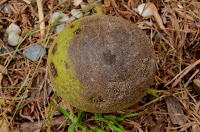What: Finally got around to adding photos. Will post again on Friday. What a beautiful windstorm we had last Tuesday night. Of course this was easy to write from the comfort of my home, free of the flying debris and desiccating winds. Walking around the next morning there was so much debris that had blown down and I imagine that too early fall storms like this take its toll on plants and the still-developing fruits and nuts of things like apples, oaks, and walnuts. These windstorms are probably more helpful for deer and turkey that can't climb trees to get access to apples. The red squirrels (
Tamiasciurus hudsonicus; "tamias" means hoarder) seemed extra pissy about it. In about 5 minutes I had collected a 5-gallon bucket's worth of walnuts, that's 5-gallons worth of walnuts the alpha red squirrel could no longer defend from the gray squirrels and beta red squirrel. In the last week since the wind knocked the walnuts down, the red squirrel has seemed less insistent about waking up at dawn to claim his territory, as though the wind was blown from his sails.
Ecological notes: We usually get these gusty Fall storms later on in the season, typically in November. Most of the debris on the ground is likely a result of all the leaves still on the trees, which catch the wind and want to be carried away. By November the leaves have fallen and the wind has a much less dramatic effect on the trees.
.JPG) |
| A uninfected husk (left) and one hosting a healthy colony of husk fly (right). |
Black walnuts (
Juglans nigra) have a thick outer husk that's filled with juglone (the same allelopath - toxic chemical - found in the roots that hinders the growth of other species). The chemical stains your hands (and can dye fabrics anything from an earthy yellow to a deep green); it also stains the mouths of squirrels this time of year. The walnut husks that have black on the outside have been colonized by a fly whose larvae eat the husk but leave the nut in tact. I cracked the one below open and found one larvae and two pupae (the shiny dark brown cylinders in the photo to the right).
.JPG) |
| Gladys eating the walnut husk fly maggots (Rhagoletis sp.) |
The shell of the walnut is super tough and sharp (apparently used as an industrial abrasive). It's got a complex labyrinth of groves and channels that the nut fits into, making it difficult to get out large chunks of the "meat" (see photo at top). So it's
a lot of work to get at the meat, but if you have lots of time, well worth the patience as it's delicious! It has a sweet minty flavor to it.
Where: All over Vermont
Other notes: Callan and I drove back from Fairfax last Tuesday night. Before we left we heard spring peepers (
Pseudacris crucifer, formerly
Hyla crucifera) calling. The roads were filled with frogs crossing back and forth. When I got home I was greeted by a chorus of gray treefrogs (
Hyla versicolor). The wet weather has brought the young amphibians out in droves. At the fall equinox, the ratio of light to dark during a day is the same as it is during the spring equinox (March 21), which is roughly the time that amphibians first start singing. One theory is that the fall chorus of frogs is from confused young males that are cuing in to daylength.
.JPG)
.JPG)


.JPG)

.JPG)
No comments:
Post a Comment